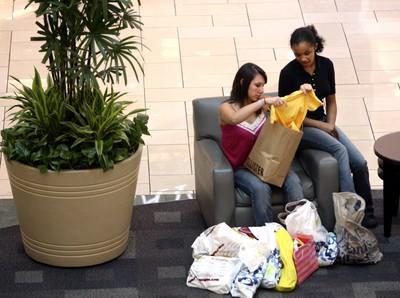CAN’T STOP THE BELL HOP
When it comes to back-to-school shopping, it's not the school supplies that cost the most, according to Nikkia Carter of Las Vegas.
Carter, a mother of three school-age kids, said pencils and paper represent a fraction of the $300 to $350 she spends on back-to-school shopping.
"That would be all the clothing and shoes and stuff," said Carter, who was shopping at Meadows mall, describing what items cost her family the most.
She was among many shoppers and their kids crowding into stores such as JC Penney, Kohl's and other back-to-school standbys Friday, the last weekday before most schools open in the Las Vegas Valley.
Despite the crowds at malls and big markdowns on backpacks, lunch boxes and clothes, back-to-school spending nationally is mostly flat in the major categories, according to retail researchers.
The National Retail Federation reported families will spend about $18.4 billion on back-to-school shopping, with the largest category of clothing and accessories remaining flat at about $7.6 billion.
"The growing category is electronics," said Phil Rist, vice president of strategy and consumer research at BIGresearch in Columbus, Ohio. "Kids lobby their parents for electronic items that don't really relate to school."
Although only 25 percent of the population has school-age kids, back-to-school shopping is an important part of the retail calendar, Rist said. That's because it comes in mid- to late summer, when retail shopping is otherwise slow.
"What else is going on in July and August?" Rist said. "They have to create reasons to buy around particular events."
Convincing people to spend is even more difficult for retailers this summer because consumers are less confident than in the recent past, said Jay McIntosh, director of consumer products for Ernst & Young.
"We think retail sales will go up during the back-to-school season but at a much slower pace than last year," McIntosh said. "The lower-income consumer is being squeezed from a number of perspectives."
McIntosh cited high energy prices, flat and falling home values and stagnant wages as reasons for consumers being more frugal this year.
"People have been funding a lot of retail spending by taking out additional equity on their homes," he said. "There was some concern about housing last year but it is obviously much more severe."
The National Retail Federation said families with school-age children will spend an average of $563 on back-to-school shopping, up from $527 last year.
Spending is forecast to increase 13 percent on electronics and by 10 percent on shoes.
Perhaps more important to families than sales figures, however, are the social dynamics at play during back-to-school shopping.
Gary Galles, a professor of economics at Pepperdine University in Malibu, Calif., said back-to-school shopping creates a classic economic conflict between parents who pay the cost and kids who derive the benefit.
"When two people have to decide on the same thing and they face radically different incentives, you can expect a lot of conflict," Galles said.
In short, because kids perceive a social benefit from acquiring certain brands or styles they often push for more spending. Parents, whose are paying for the items, are less likely to care about the social benefit and more likely to focus on the cost.
"The problem arises because when you are spending a dollar on something, it doesn't cost the kid anything," he said. "The kid is always going to want more and better."
One way to minimize conflict would be to let kids choose what they want, but within a firm budget. That way, the parents won't go over-budget and the kids will be forced to prioritize what they truly need, Galles said.
Carter said she lets her kids pick what they want until the cost starts to get too high.
"Then I take over and start cutting to stuff that is the most important," she said.

















